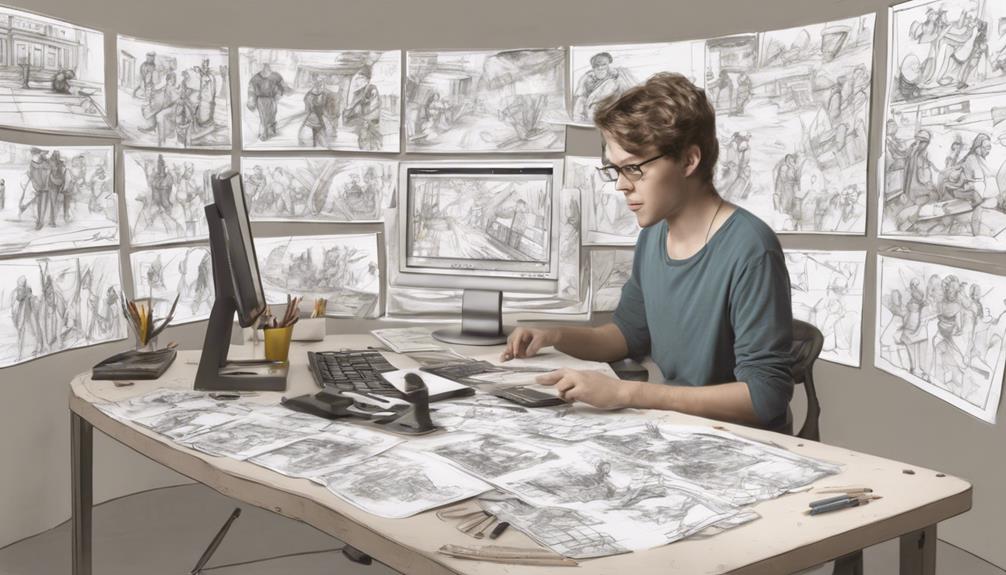The intricate process of creating cartoons and animations involves a blend of creativity and technology, from script development to final production. Understanding the role of animators, the collaborative nature of the industry, and the evolution of animation techniques sheds light on the complexity behind the seemingly seamless finished products. By exploring the tools and software used, the transition from traditional to modern methods, and the importance of storyboarding, one can truly grasp the artistry and innovation involved in bringing animated worlds to life.
Key Takeaways
- Animations created frame by frame with meticulous attention to detail
- Collaboration among various artistic disciplines for a cohesive final product
- Utilization of advanced animation software and techniques for seamless motion
- Teamwork and integration crucial in aligning elements with the project vision
Understanding the Animation Process
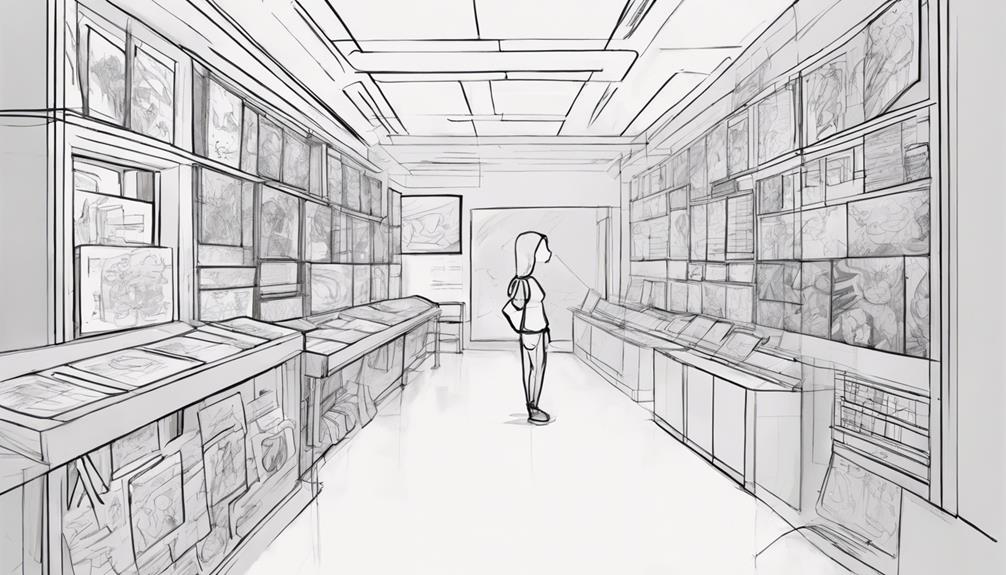
How is the intricate process of animation meticulously orchestrated to breathe life into characters and narratives on screen? Animators employ a meticulous approach, posing characters frame by frame to convey emotions and actions effectively. Through this method, they create seamless motion in animations, allowing characters to come alive on screen. Utilizing advanced animation techniques, such as those found in software like Toon Boom Harmony and Anime Studio, animators can blend 2D and 3D elements to enhance visual appeal and storytelling.
Role of the Animator
The animator's pivotal role in the animation process lies in meticulously crafting character movements and expressions frame by frame to bring them to life on screen. Animators work on character animation, focusing on details like facial expressions, gestures, and body language. They utilize keyframe techniques to animate individual parts of characters, ensuring precise control over movements. By posing characters in key frames and creating movements to convey emotions and actions, animators bring animated characters to life. In computer animation, software is used to generate in-between frames, ensuring smooth transitions between key poses. Studios like Pixar employ advanced tools and techniques to guarantee that character performances are not only believable but also engaging for the audience.
| Key Frames | Detail-focused animation | Precise movement control |
|---|---|---|
| Facial Expressions | Gestures | Body Language |
Creative Collaboration in Animation
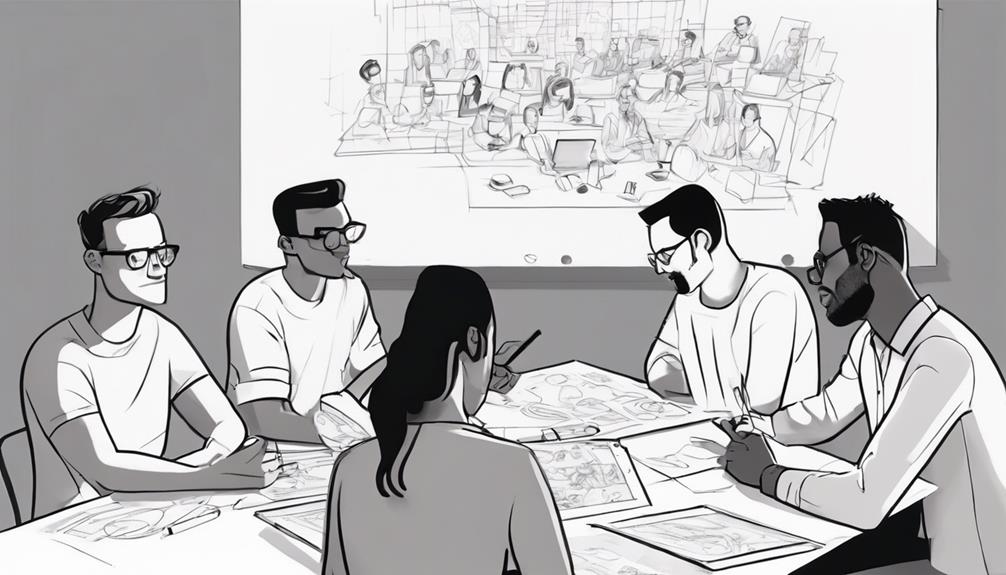
Creative collaboration in animation is a multifaceted process that involves the seamless integration of various artistic disciplines to achieve a common goal. Teamwork plays a crucial role in ensuring that each element of the animation process aligns with the overall vision and artistic direction of the project. Through collaboration, writers, artists, animators, voice actors, and musicians bring their unique expertise together to create a cohesive and engaging final product.
Teamwork in Animation
Effective collaboration among various departments in animation production is crucial for the successful creation of cohesive and engaging animated works. Animators work closely with storyboard artists to visually bring the script to life through character movements and expressions. Voice actors collaborate with animators to ensure their performances align with the character animations and emotions depicted on screen. Additionally, musicians work hand in hand with animators to craft soundtracks that enhance the emotional impact of scenes and complement the animation. This teamwork ensures that all aspects of the animation align harmoniously to create a captivating final product. Clear communication and collaboration among animators, voice actors, musicians, and other team members are vital for the seamless integration of different elements in animated productions.
| Department | Collaboration |
|---|---|
| Animators | Work closely with storyboard artists |
| Voice Actors | Collaborate to match performances with animations |
| Musicians | Craft soundtracks to enhance emotional impact |
| Team Members | Communicate effectively for cohesive integration |
Artistic Vision Alignment
Artistic collaboration in animation involves the synchronization of creative visions among writers, animators, and directors to materialize characters and narratives. Writers play a crucial role in crafting scripts that outline character actions and dialogue, ensuring the preservation of the creative vision throughout the animation process. Animators collaborate closely with directors to translate these scripts into visual scenes, considering camera angles and character performances in line with the intended artistic direction. The collaborative process in animation includes iterative feedback loops during storyboarding, voice recording, and animatic stages to continually refine the artistic vision and storytelling elements. By aligning their creative visions, the animation team can produce a coherent and captivating final product that resonates with audiences, showcasing their collective creative talents.
Tools and Software in Animation
Animation production heavily relies on specialized tools and software to bring characters and stories to life with precision and efficiency. Modern 2D animation often employs software like Toon Boom Harmony and Anime Studio, allowing animators to create intricate animations. These programs offer features such as the ability to break character models into parts for easier manipulation and the inclusion of automatic lip-syncing to synchronize dialogue with character movements. Additionally, the use of 2D shaders in 3D animation software enables the creation of animations that have a 2D appearance within a 3D environment. Industry giants like Disney and Nickelodeon utilize industry-standard software such as Toon Boom Harmony for producing animated episodes. By leveraging these advanced tools and software, animators can streamline their workflow, enhance productivity, and achieve the level of detail required for creating captivating animated films.
Evolution of Animation Techniques
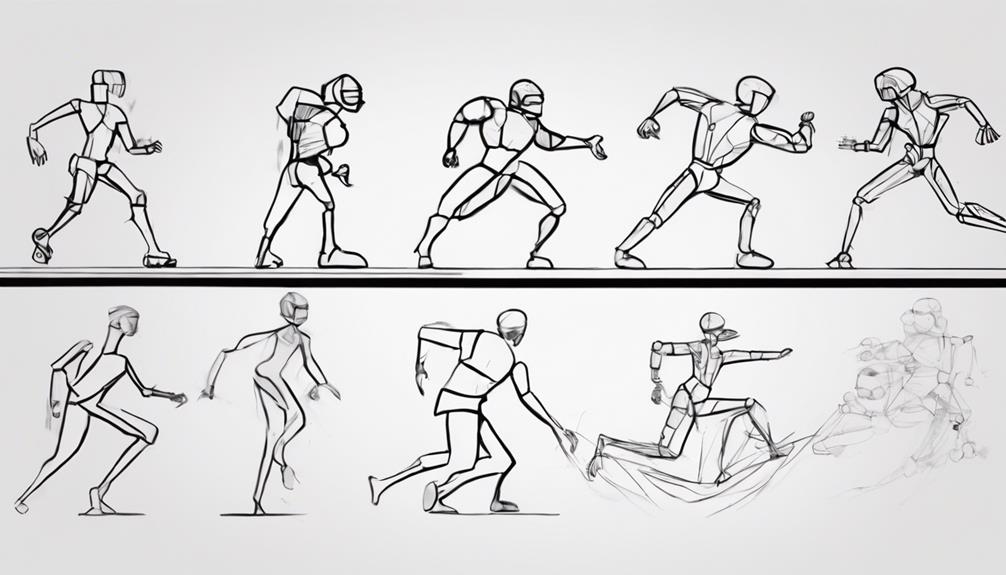
The evolution of animation techniques has been marked by significant milestones, ranging from early animation methods to modern digital advancements and the incorporation of motion capture technology. These developments have transformed the landscape of animation production, enhancing creativity and efficiency in the industry. By exploring these key points, we can gain a deeper understanding of the continuous innovation that shapes the art of animation.
Early Animation Methods
During the early stages of animation development, frame-by-frame hand-drawn images on transparent cels formed the foundation of pioneering animation methods. Techniques such as cel animation, which involved drawing characters and backgrounds on separate cels to streamline production, and rotoscoping, a method of tracing over live-action footage for realistic movement, were prominent. The multiplane camera introduced depth and parallax effects to traditional animation by enabling different layers of artwork to move independently. Xerography played a crucial role in animation by allowing cost-effective reproduction of hand-drawn images onto cels. Innovations like the APT process further revolutionized animation production by transferring images onto cels using litho film, marking significant advancements in the evolution of animation techniques.
Digital Animation Advancements
Pioneering the way for modern animation techniques, the advent of digital animation has fundamentally reshaped the industry's landscape. Digital animation leverages computer-based systems and animation programs to create intricate 2D and 3D animations. Industry-standard software like Toon Boom Harmony and Adobe Flash empower animators to seamlessly integrate various elements for more efficient production processes. The combination of 2D and 3D animation techniques in digital animation allows for visually stunning results in cartoons and animated films. Moreover, digital animation tools have revolutionized the way artists animate characters, providing them with enhanced storytelling capabilities and streamlining the overall animation process.
| Digital Animation Advancements | |
|---|---|
| Computer-based Systems | Animation Programs |
| 2D and 3D Animation Techniques | Digital Animation Tools |
Motion Capture Technology
Revolutionizing the animation industry, Motion Capture Technology has significantly evolved animation techniques by capturing real-life movements and translating them into digital animations with unparalleled realism. By using special suits with markers tracked by cameras, actors' movements are recorded and transformed into data that animators bring to life using a computer program. This technology enables the creation of lifelike animations with fluid motions, enhancing the realism of animated films. Motion capture technology ensures that characters move naturally within animation frames, providing a level of detail and authenticity that was challenging to achieve with traditional animation methods. Its widespread use in the film industry has streamlined the process of producing high-quality, realistic animations efficiently.
Traditional Vs. Modern Animation Methods
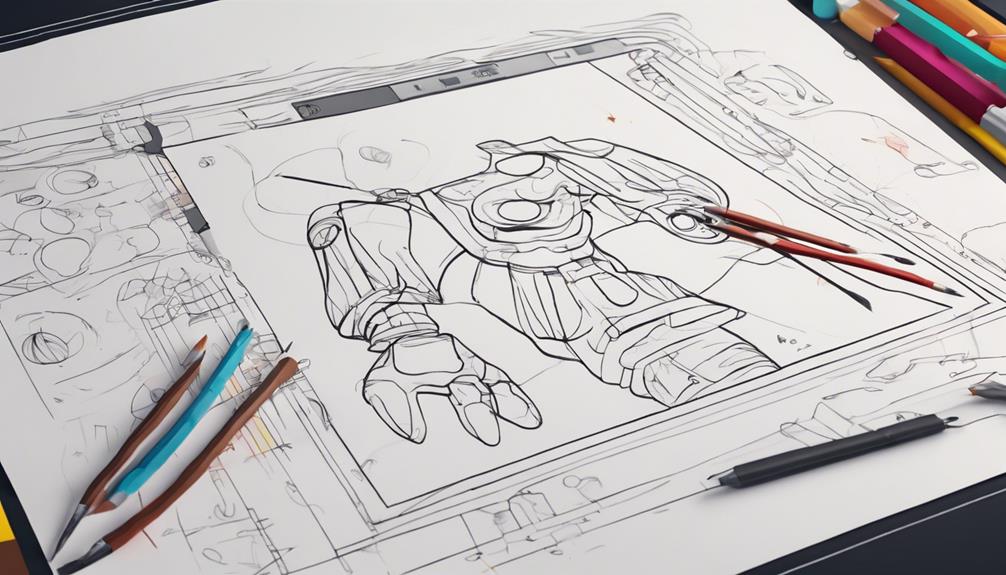
In comparing traditional and modern animation methods, the shift towards digital tools and software has significantly transformed the industry's production processes. Traditional animation techniques, such as cel animation and multiplane camera, required hand-drawn frames on celluloid sheets, a time-consuming process. In contrast, modern animation integrates digital tools, blending 2D and 3D elements seamlessly for enhanced visual effects. One significant change is the replacement of traditional hand painting with digital ink and paint processes in modern animation studios, offering cost-effectiveness and faster production turnaround. Modern animators leverage software packages like Toon Boom Harmony and Anime Studio, which provide automation and efficiency in creating animated series. Industry standards like Toon Boom Harmony and Adobe Flash have evolved with technology, influencing the tools and software used in both traditional and modern animation processes. This transition highlights the industry's adaptation to digital advancements, catering to the needs and expectations of contemporary audiences and production demands.
Importance of Storyboarding in Animation
The process of creating a cohesive and visually engaging animation begins with the meticulous and essential step of storyboarding. Storyboarding in animation is a key element in the pre-production process, essential for laying the foundation of visual storytelling. Here are some reasons why storyboarding holds significance in the animation industry:
- Visualization: Storyboarding helps in visualizing the story flow, camera angles, character movements, and scene transitions.
- Guidance: It serves as a guide for animators, directors, and team members, ensuring consistency in storytelling and character expressions.
- Refinement: Allows for adjustments and improvements to script, pacing, and overall visual storytelling before full production.
- Narrative Coherence: Crucial for ensuring the final animated product has a coherent narrative and visual appeal.
Career Opportunities in Animation Industry
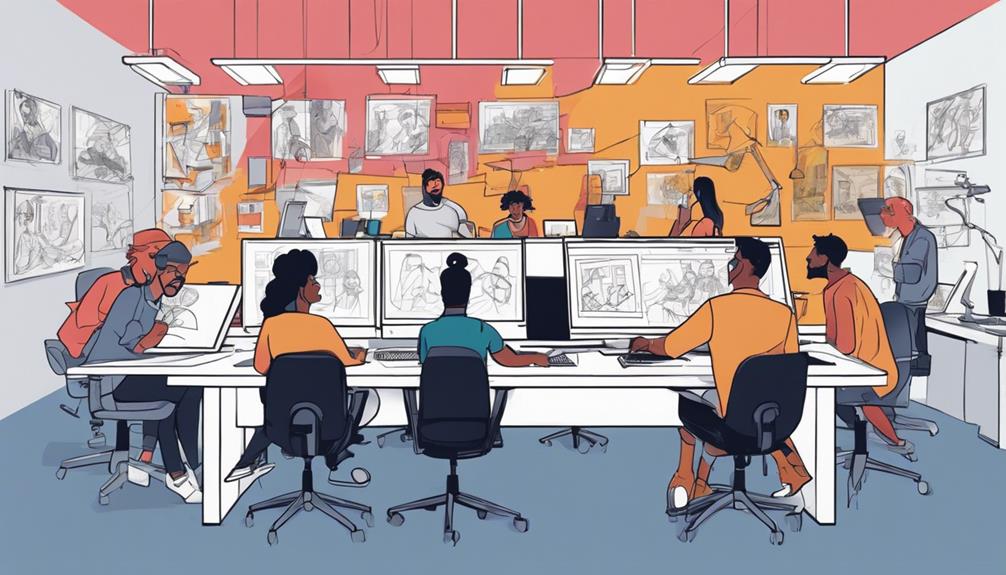
Career opportunities within the animation industry encompass a wide range of roles, including animators, modelers, writers, musicians, and voice actors, each contributing uniquely to the creation of animated projects. Animators play a crucial role in bringing characters to life by infusing them with movement and emotion, while modelers are responsible for creating intricate 3D assets that form the visual basis of animations. Writers are essential in crafting compelling storylines for animated shows, enriching the overall narrative and engaging the audience. Musicians add depth and atmosphere to animations through carefully composed soundtracks and background music, enhancing the viewer's experience. Voice actors give voice and personality to animated characters, using their vocal talents to breathe life into scripts and create memorable performances. These diverse career paths offer opportunities for individuals with varying skills and talents to contribute to the vibrant and dynamic world of animation.
Frequently Asked Questions
How Animation Is Made Step by Step?
In the creation of animation, techniques such as frame-by-frame animation are employed to bring characters and scenes to life. Character design is meticulously crafted to capture the essence of the story and convey emotions effectively. The storyboarding process is essential for visualizing sequences and ensuring continuity. Animation software plays a vital role in rendering movements and transitions seamlessly. These steps collectively contribute to the intricate process of animating captivating stories with precision and artistry.
How Was Animation Created?
The evolution of animation has been a fascinating journey, stemming from the creation of rapid image sequences to generate motion illusions. Through the pioneering work of animators like Winsor McCay and Disney, techniques such as cel overlay and multiplane animation were introduced, shaping the landscape of animation. Notably, the transition to digital ink and paint has revolutionized traditional methods, making a significant impact on the industry by streamlining processes and enhancing creative possibilities.
How Do Animators Animate?
In the realm of animation, animators bring characters to life through a meticulous process of employing various animation techniques. Character movements are carefully crafted utilizing frame-by-frame animation and tweening to ensure fluidity and realism. The storyboarding process serves as a crucial foundation for animators to visualize scenes and plan character actions. Frame rates dictate the smoothness of animations, while software tools like Adobe Animate and Toon Boom Harmony aid in the creation of captivating animated content.
How Long Does It Take to Animate 30 Minutes?
Time management in animation is crucial for meeting project deadlines. A 30-minute cartoon episode typically takes 6 to 9 months to animate. This duration accounts for the intricate animation process, production timeline, and workflow efficiency needed to ensure quality. Multiple episodes are often in simultaneous production to maintain a consistent release schedule. Effective time management is essential in delivering a high-definition master tape to networks for broadcasting.
Conclusion
In conclusion, the intricate process of creating cartoons and animations involves a blend of traditional and modern techniques, supported by advanced software and tools. The evolution of animation has revolutionized the industry, allowing for seamless integration of different elements and the creation of high-quality content. Through creative collaboration and meticulous attention to detail, animators bring characters to life and convey emotions effectively. Overall, the animation industry offers a wealth of career opportunities for those skilled in the art of storytelling through visual media.
